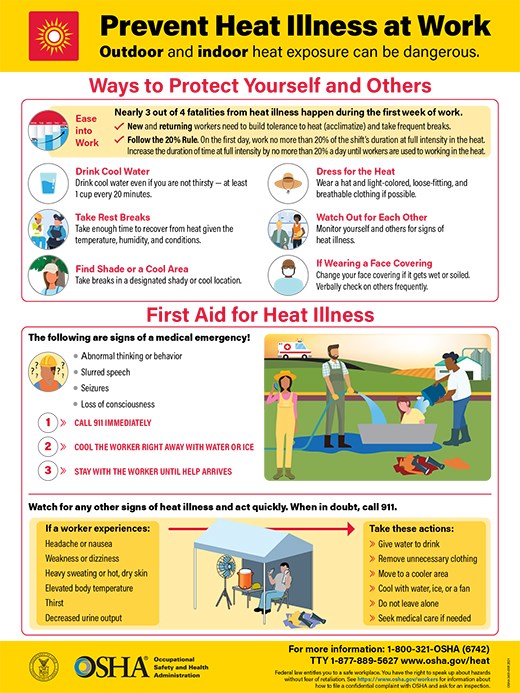OSHA | Prevent Heat Illness at Work
With most areas of the U.S. currently experiencing extreme heat, we wanted to re-share our post about preventing heat illness at work, from earlier this month.
Outdoor and indoor heat exposure can be dangerous.
Nearly 3 out of 4 fatalities from heat illness happen during the first week of working in the heat. Workers need to ease into working in warm or hot environments.
- New and returning workers need to build a tolerance to working in the heat (acclimatize) and take frequent breaks
- Follow the 20% rule — on the first day, work no more than 20% of the shift’s duration at full intensity in the heat. Increase the duration of time at full intensity by no more than 20% a day until workers are used to working in the heat
Additional tips to protect yourself and others while working in the heat include:
- Drink cool water — even if you’re not thirsty, drink at least one cup every 20 minutes
- Take rest breaks — take enough time to recover from heat given the temperature, humidity, and conditions
- Find shade or a cool area — take breaks in a designated shady location or cool area
- Dress for the heat — wear a hat and light-colored, loose-fitting, and breathable clothing if possible
- Watch out for each other — monitor yourself and others for signs of heat illness
- If wearing a face covering — change your face covering if it gets wet or soiled. Verbally check on others frequently
Signs of Heat Illness
The following are signs of heat illness and a medical emergency:
- Abnormal thinking or behavior
- Slurred speech
- Seizures
- Loss of consciousness
If any of the above signs are noticed, call 911 immediately. Once 911 has been called, cool the worker right away with water or ice and stay with the worker until help arrives.
Other signs of heat illness that need prompt action include:
- Headache or nausea
- Weakness or dizziness
- Heavy sweating or hot, dry skin
- Elevated body temperature
- Thirst
- Decreased urine output
In 2011, OSHA launched its Heat Illness Prevention campaign which educates employers and workers on the dangers of working in the heat. View OSHA’s full Prevent Heat Illness at Work poster here: https://www.osha.gov/.../publica.../3431_wksiteposter_en.pdf
Credit to: OSHA
